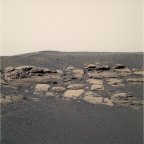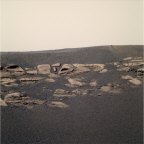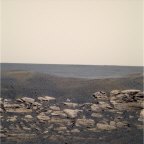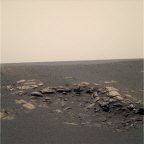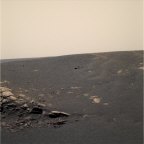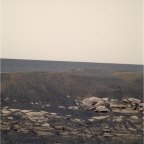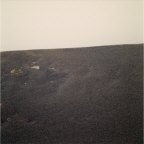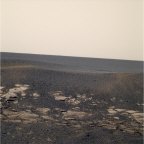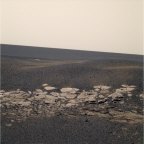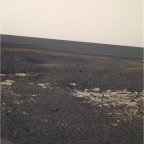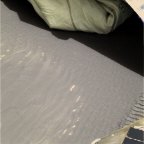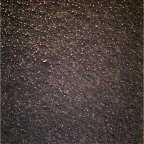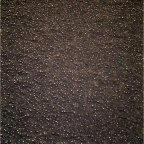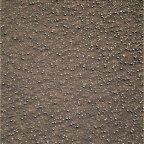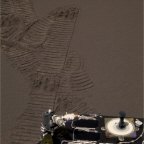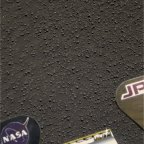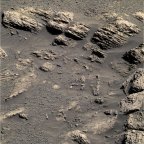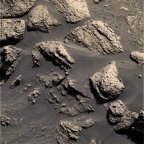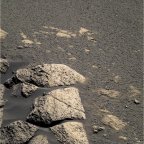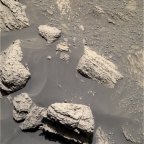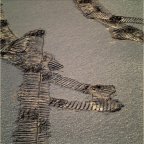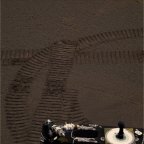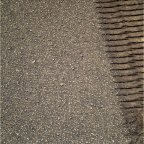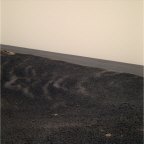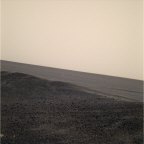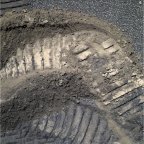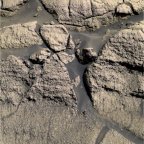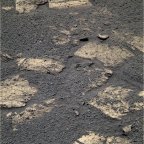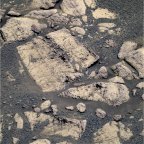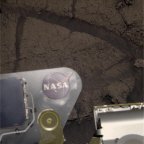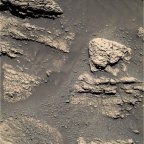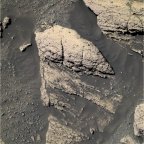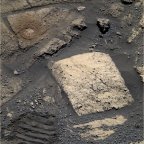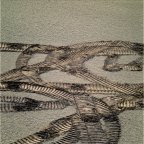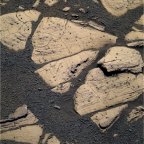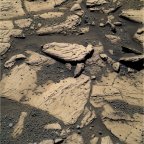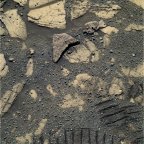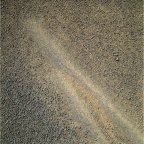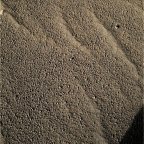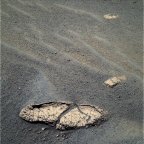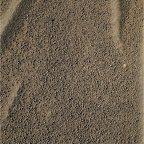Full Size Images from Opportunity
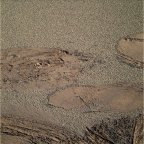
Opportunity, Sol 3 15:20
This image taken by the Mars Exploration Rover Opportunity's panoramic camera shows where the rover's airbags left impressions in the martian soil. The drag marks were made after the rover successfully landed at Meridiani Planum and its airbags were retracted. The rover can be seen in the foreground.
Image credit: NASA/JPL/Cornell
1/27/2004
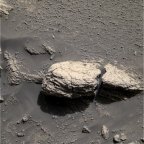
Opportunity, Sol 14 10:21
A region at the end of the rock outcrop lining the small crater, called "Eagle Crater." The sphere-like grains or "blueberries" dotting the rocks in the outcrop can also be seen above the rocks, suggesting that these geologic features have origins beyond Eagle Crater.
2/7/2004
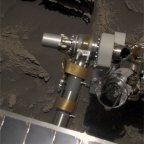
Opportunity, Sol 15 12:20
Rock abrasion tool, also known as "rat" (circular device in center), located on the rover's instrument deployment device, or "arm."
2/8/2004
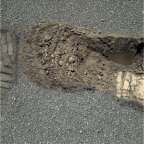
Opportunity, Sol 26 11:59
The Mars Exploration Rover Opportunity dragged one of its wheels back and forth across the sandy soil at Meridiani Planum to create a hole (bottom left corner) approximately 50 centimeters (19.7 inches) long by 20 centimeters (7.9 inches) wide by 9 centimeters (3.5 inches) deep. The rover's instrument deployment device, or arm, will begin studying the fresh soil at the bottom of this trench later today for clues to its mineral composition and history. Scientists chose this particular site for digging because previous data taken by the rover's miniature thermal emission spectrometer indicated that it contains crystalline hematite, a mineral that sometimes forms in the presence of water. The brightness of the newly-exposed soil is thought to be either intrinsic to the soil itself, or a reflection of the Sun.
2/19/2004
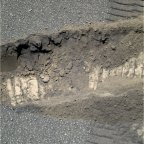
Opportunity, Sol 26 12:07
The Mars Exploration Rover Opportunity dragged one of its wheels back and forth across the sandy soil at Meridiani Planum to create a hole (bottom left corner) approximately 50 centimeters (19.7 inches) long by 20 centimeters (7.9 inches) wide by 9 centimeters (3.5 inches) deep. The rover's instrument deployment device, or arm, will begin studying the fresh soil at the bottom of this trench later today for clues to its mineral composition and history. Scientists chose this particular site for digging because previous data taken by the rover's miniature thermal emission spectrometer indicated that it contains crystalline hematite, a mineral that sometimes forms in the presence of water. The brightness of the newly-exposed soil is thought to be either intrinsic to the soil itself, or a reflection of the Sun.
2/19/2004
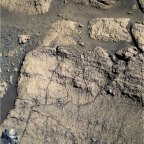
Opportunity, Sol 27 10:24
The "El Capitan" region of the rock outcrop at Meridiani Planum, Mars.
2/20/2004
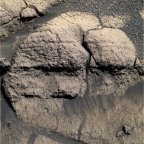
Opportunity, Sol 27 10:53
The "El Capitan" region of the rock outcrop at Meridiani Planum, Mars. This image shows fine, parallel lamination in the upper area of the rock, which also contains scattered sphere-shaped objects ranging from 1 to 2 millimeters (.04 to .08 inches) in size. There are also more abundant, scattered vugs, or small cavities, that are shaped like discs. These are about 1 centimeter (0.4 inches) long.
2/20/2004
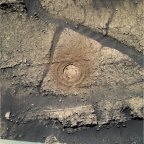
Opportunity, Sol 36 13:11
This hole was made by the rover's rock abrasion tool, located on its instrument deployment device, or "arm." The hole is located on a target called "McKittrick" at the "El Capitan" region of the Meridiani Planum, Mars, rock outcrop. It was made on the 30th martian day, or sol, of Opportunity's journey.
The grinding process at has generated a significant amount of reddish dust. Color and spectral properties of the dust show that it may contain some fine-grained crystalline red hematite.
Courtesy NASA/JPL
3/1/2004
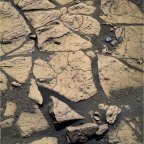
Opportunity, Sol 50 11:33
"Shoemaker's Patio" near the Mars Exploration Rover Opportunity's landing site, shows finely layered sediments, which have been accentuated by erosion. The sphere-like grains or "blueberries" distributed throughout the outcrop can be seen lining up with individual layers. This observation indicates that the spherules are geologic features called concretions, which form in pre-existing wet sediments. Other sphere-like grains, such as impact spherules or volcanic lapilli (fragments of material between 2 and 64 millimeters or .08 and 2.5 inches in maximum dimension that are ejected from a volcano) are thought to be deposited with sediments and thus would form layers distinct from those of the rocks. This image was captured by the rover's panoramic camera on the 50th martian day, or sol, of the mission.
3/15/2004
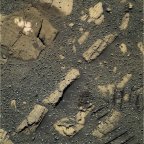
Opportunity, Sol 51 12:49
Dubbed "Carousel," the rock in this image was the target of the Mars Exploration Rover Opportunity science team's outcrop "scuff test." On sol 51 (March 15, 2004), Opportunity slowly rotated its left front wheel on the rock, abrading it in the same way that geology students use a scratch test to determine the hardness of minerals. The image on the right, taken by the rover's navigation camera on sol 51, shows the rock post-scuff. In this image, it is apparent that Opportunity scratched the surface of "Carousel" and deposited dirt that it was carrying in its wheel rims.
3/16/2004
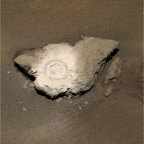
Opportunity, Sol 68 12:56
This hole was ground by the rover's rock abrasion tool into "Bounce" rock. The rock measures approximately 35 centimeters (14 inches) long and 10 centimeters (4 inches) high. The depression measures 6.44 millimeters (0.25 inch) deep and about 4.5 centimeters (1.7 inches) across. The grinding procedure took place on the rover's 66th sol on Mars and lasted 2 hours and 15 minutes. A combination of limited solar power, added safety measures and the rock's jagged texture led the rock abrasion tool team to set more aggressive grinding parameters to ensure that the end result was a full circle, suitable for a thorough read from the rover's spectrometers.
Bounce's outer ring consists of the cuttings from the rock, pushed out by the brushes on the grinding instrument. The small impressions filled with red dust on the outer ring were caused by the instrument's contact mechanism, which serves to stabilize it while grinding.
4/3/2004
